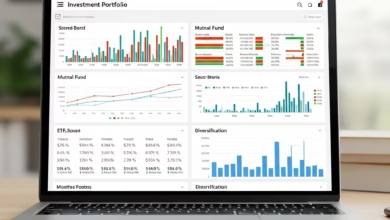How much of my salary should I invest per month?
Find out how much of your salary you should invest each month

It’s a question almost everyone asks when they start thinking about their financial future: “How much should I be investing each month?” There’s no single magic number, as the ideal amount depends heavily on your individual circumstances, goals, and current financial situation. However, there are smart guidelines and principles that can help you figure out the perfect investment strategy for you. Let’s explore how to determine what makes sense for your wallet and your dreams.
Setting the Stage: Understanding Your Financial Landscape

Before you even think about percentages, it’s crucial to get a clear picture of your current income, expenses, and financial priorities. This foundational step will ensure your investment plan is realistic and sustainable.
- 1. Assess Your Income and Expenses: The very first step is to know exactly how much money comes in each month and where it all goes. Create a detailed budget that tracks your income and all your expenses – fixed costs like rent/mortgage, utilities, and loan payments, as well as variable costs like groceries, entertainment, and dining out. This will reveal your “disposable income,” which is the money left over after essential bills are paid.
- 2. Build an Emergency Fund: Before you start investing for long-term goals, make sure you have a solid emergency fund. This is typically 3 to 6 months’ worth of essential living expenses saved in an easily accessible, liquid account (like a high-yield savings account). This fund acts as a safety net, preventing you from needing to sell investments prematurely if an unexpected expense arises.
- 3. Tackle High-Interest Debt: If you have high-interest debts like credit card balances or personal loans, it’s generally wise to prioritize paying these down before aggressively investing. The interest you save often outweighs the potential returns you might earn from investments, effectively giving you a guaranteed “return.”
Strategic Savings: Popular Guidelines and Your Personal Goals
Once your financial foundation is solid, you can start looking at popular investment guidelines and tailor them to your unique aspirations. Remember, these are starting points, not rigid rules.
- 4. The 50/30/20 Rule: A Great Starting Point: A popular budgeting guideline suggests allocating your after-tax income this way:
- 50% for Needs: Housing, utilities, groceries, transportation, insurance.
- 30% for Wants: Dining out, entertainment, hobbies, vacations, shopping.
- 20% for Savings & Debt Repayment: This 20% is where your investments, emergency fund contributions, and extra debt payments (beyond minimums) fit in. This rule makes it easy to visualize how much you could be saving.
- 5. Optimize for Your Goals: While 20% is a good baseline, your personal goals might dictate a different amount.
- Early Retirement? You might aim for 30%, 40%, or even 50% if possible.
- Large Down Payment Soon? You might temporarily increase your investment rate to reach that goal faster.
- Just Starting Out? Even a small amount, like 5% or 10%, is better than nothing. The power of compounding means that even small, consistent investments made early on can grow significantly over time.
- 6. Consider Your Employer’s Retirement Plan: If your employer offers a retirement plan like a 401(k) or 403(b), especially one with a matching contribution, contributing at least enough to get the full match is often considered “free money.” This should be a top priority before investing elsewhere, as it’s an immediate 100% return on your investment.
Sustaining Your Strategy: Consistency and Review for Long-Term Growth

Investing isn’t a one-time decision; it’s an ongoing process. Regular review and adjustment will help ensure your investment strategy remains aligned with your changing life and financial situation.
- 7. Automate Your Investments: Make saving and investing easy by setting up automatic transfers from your checking account to your investment account each payday. This removes the temptation to spend the money and ensures consistency. “Out of sight, out of mind” can be a powerful tool for building wealth.
- 8. Increase Your Contributions Over Time: As your income grows, try to increase your investment contributions. Even small raises can make a big difference if you dedicate a portion of them to your investments instead of increasing your lifestyle spending. This is known as “paying yourself first.”
- 9. Review and Adjust Annually: Your life changes, and so should your financial plan. Once a year, review your budget, goals, and investment performance. Are you still on track? Do your risk tolerance or goals need to be updated? Adjust your investment amount or strategy as needed.
Your Investment Journey Starts Now

Determining how much of your salary to invest each month is a personal decision, but by following these steps, you can create a realistic and effective plan. Start by understanding your current finances, secure your emergency fund, prioritize high-interest debt, and then set a sustainable investment goal. Remember, the most important thing isn’t a specific percentage, but the habit of consistent investing.





